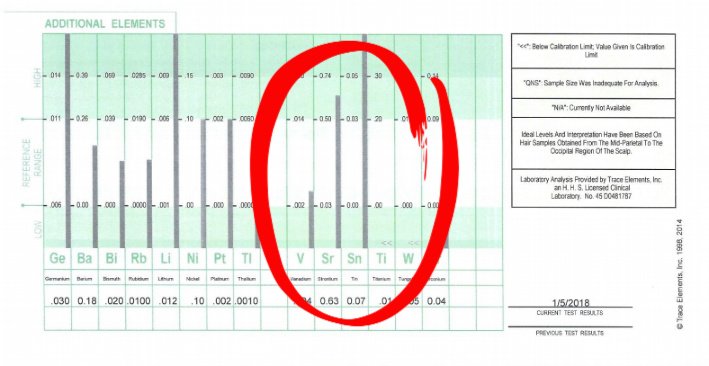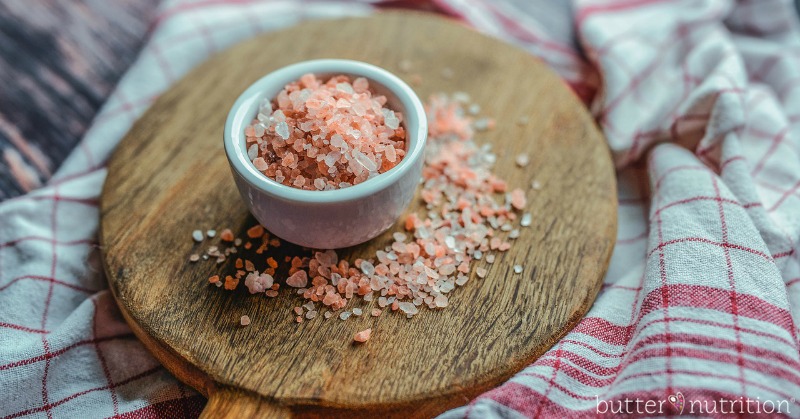Pink Himalayan salt is a pretty popular trend these days with the health crowd, but from my personal experience, there are good reasons not to use it.
I surely wouldn’t be writing this without collecting data from hundreds of clients from all over the world (thank you to all my wonderful clients that participated in my salt study!).
When doing Hair Tissue Mineral Analysis (HTMA) with my clients, we assess the hair for around 35 different minerals, including — calcium, magnesium, sodium, potassium, copper, zinc, phosphorus, iron, manganese, chromium, selenium, cobalt, germanium, molybdenum, sulfur, uranium, arsenic, beryllium, mercury, cadmium, lead, aluminum, barium, bismuth, rubidium, lithium, nickel, platinum, thallium, vanadium, strontium, tin, titanium, tungsten, and zirconium.
“Hair is a keratinized tissue consisting of protein. As the hair is being formed it is exposed to the internal metabolic environment including the blood, lymph, and extracellular fluids. Constituents entering the body are then accumulated into the hair and reflect a time-weighted exposure record of nutritional and toxic metal intake.” [4]
Something I see frequently with my clients is high-ish tin levels according to their hair tissue mineral analysis report (available internationally).

SOURCES OF TIN
There are several common sources of tin, like: [1]
- Canned Foods
- Herbs
- Fungicides
- Dental Treatments
- Toothpaste
- Cooking Utensils
- Solders
- Dental Fillings
- PVC
- Ceramics
- Stannous Fluoride
- Marine Paints
- Collapsible Metal Containers
- Mining
But one source of tin I see much more than others is pink Himalayan salt. In fact, it’s now the number one question I ask my clients when I see elevated tin levels.
SO WHAT IS WRONG WITH HIGH TIN?
Tin doesn’t have a biological function in the human body, and tin levels should hover close to zero. According to Trace Element Lab, “it has been reported that an excessive level of tin can interfere with iron metabolism and will produce heme breakdown. Elevated tin also increases the excretion of selenium and zinc from the body.” [1]
Tin toxicity is also linked with the following symptoms [3, 9]:
- abdominal pain
- vomiting
- nausea
- chronic fatigue syndrome
- skin and eye irritation
- cholangitis of the lower biliary tract
- hepatotoxicity
- neurotoxicity
- psychomotor disturbance
- depression
- headache
- liver damage
OTHER CONCERNS WITH PINK HIMALAYAN SALT (HINT: HEAVY METALS)
Aside from my concerns about pink Himalayan salt contributing to higher tin levels, there are other problems with the popular salt.
According to The Meadow Spectral Analysis, the following are the minerals found in pink Himalayan salt:
“actinium, aluminum, antimony, arsenic, astatine, barium, beryllium, bismuth, boron, bromine, cadmium, calcium, carbon, cerium, cesium, chlorine, chromium, cobalt, copper, dysprosium, erbium, europium, fluorine, francium, gadolinium, gallium, germanium, gold, hafnium, holmium, hydrogen, indium, iodine, iridium, iron, lanthanum, lead, lithium, lutetium, magnesium, manganese, mercury, molybdenum, neodymium, neptunium, nickel, niobium, nitrogen, osmium, oxygen, palladium, phosphorus, platinum, plutonium, polonium*, potassium, praseodymium, protactinium, radium*, rhenium, rhodium, rubidium, ruthenium, samarium, scandium, selenium, silicon, silver, sodium, strontium, sulfur, tantalum, tellurium, terbium, thallium^^, thorium, thulium, tin, titanium, uranium*, vanadium, wolfram, yttrium, ytterbium, zinc and zirconium.”
According to a 2020 study, heavy metals in pink salt can pose serious concern:
Speculation about about lead in pink salt is not new. [10]
Other concerns include that iron oxide (a.k.a rust) is what that gives pink Himalayan salt it’s rosy color [6, 7], as well as the environmental concerns associated with importing fancy salt that is a finite resource from the mines in Pakistan.
While pink Himalayan salt may have tiny amounts of minerals that are good for health, it also contains those that are not good for your health as well, outweighing any positive benefit.
Based on this and what I see in HTMA data, I choose to use a plain white Kosher salt without additives (like this or this).
When it comes down to what salt to use, it’s a personal decision. Take my clinical opinion and observations with a grain of salt and do what feels best for you
